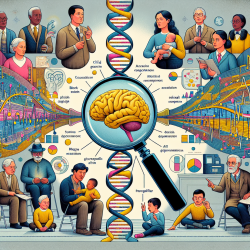Introduction
In the realm of speech-language pathology, innovative approaches often emerge from interdisciplinary research. One such intriguing study is "1/f Laws Found in Non-Human Music," which examines the prevalence of 1/f power-law distributions in animal vocalizations. This research holds potential implications for speech therapists, particularly those involved in online therapy services like TinyEYE, by offering new insights into auditory processing and communication.
Understanding 1/f Laws
The 1/f power-law distribution, also known as a fractal structure, is a mathematical concept that describes how certain types of signals or patterns are self-similar across different scales. In the context of music and vocalizations, this means that the rhythm and spectral density of sounds exhibit a predictable pattern that balances between randomness and structure. This study demonstrates that such patterns are not exclusive to human music but are also present in the vocalizations of various animal species, including songbirds, whales, and wolves.
Implications for Speech Therapy
The findings from this research can be transformative for speech therapists in several ways:
- Enhanced Auditory Processing: Understanding the natural occurrence of 1/f patterns in animal vocalizations can help therapists develop better auditory processing strategies for children. By recognizing these patterns, therapists can create exercises that mimic natural sound environments, potentially improving auditory discrimination and attention.
- Music Therapy Integration: Since 1/f patterns are prevalent in both human and non-human music, integrating music therapy that emphasizes these patterns could enhance therapeutic outcomes. This approach can be particularly beneficial for children with speech and language delays, as music has been shown to support language development.
- Adaptive Communication Strategies: The study suggests that sensitivity to 1/f patterns may be an evolutionary trait. Speech therapists can leverage this understanding to develop communication strategies that align with these natural auditory preferences, potentially making therapy more intuitive and effective.
Encouraging Further Research
While the current study provides a compelling foundation, further research is needed to explore the direct applications of 1/f laws in speech therapy. Practitioners are encouraged to collaborate with researchers in fields such as neuroscience and bioacoustics to deepen our understanding of how these patterns can be harnessed in therapeutic settings.
Conclusion
The intersection of music, biology, and mathematics offers exciting opportunities for advancing speech therapy practices. By embracing data-driven insights from studies like "1/f Laws Found in Non-Human Music," therapists can enhance their methodologies and contribute to better outcomes for children. For those interested in delving deeper into the original research, please follow this link: 1/f laws found in non-human music.










